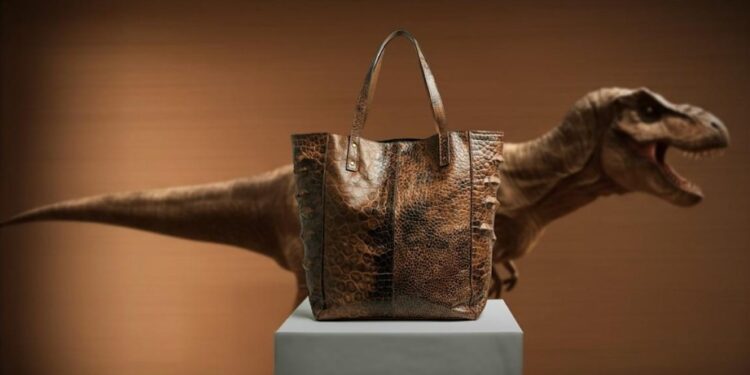Imagine carregar uma bolsa feita de couro de um animal que desapareceu há 68 milhões de anos. Parece ficção científica, mas cientistas do Reino Unido estão trabalhando para transformar essa ideia em realidade. Usando tecnologia de engenharia genética e colágeno extraído de fósseis de tiranossauro rex, uma equipe interdisciplinar está tentando criar acessórios de luxo com pele “cultivada” no laboratório a partir de material genético desse temível predador pré-histórico.
O projeto é liderado por pesquisadores da Lab-Grown Leather, uma empresa de biotecnologia baseada em Newcastle, em colaboração com a The Organoid Company, especializada em engenharia genômica, e a agência criativa holandesa VML. O objetivo não é apenas impressionar o mundo da moda, mas também propor uma alternativa sustentável e “eticamente correta” ao couro tradicional — mesmo que venha de uma espécie extinta.
Do Laboratório ao Closet: Como Funciona?
A iniciativa parte de uma descoberta recente na paleontologia: fragmentos de colágeno preservados em fósseis de dinossauros, como o tiranossauro rex. Embora o DNA completo seja impossível de ser recuperado após milhões de anos, os cientistas conseguiram extrair pedaços dessa proteína crucial, essencial para formar colágeno, principal componente estrutural da pele.
A partir desses fragmentos, os pesquisadores utilizam técnicas avançadas de engenharia genômica para reconstruir digitalmente a sequência completa de colágeno do T. rex. Esse material genético é então introduzido em linhas celulares especialmente desenvolvidas em laboratório, onde as células começam a produzir colágeno idêntico ao que teria composto a pele do gigante pré-histórico.
Segundo o professor Che Connon, especialista em engenharia de tecidos da Universidade de Newcastle e líder do projeto, o processo elimina a necessidade de materiais derivados de animais vivos ou de preenchimentos sintéticos, tornando o produto final 100% biodegradável e estruturalmente semelhante ao couro convencional. “Estamos desbloqueando o potencial de engenhar couro de espécies pré-históricas, começando com o formidável T. rex”, afirmou Connon. “Isso demonstra o poder da tecnologia celular para criar materiais inovadores e éticos.”
Uma Ideia Louca ou Visionária?
Embora a ideia pareça saída de um filme de Hollywood, os cientistas envolvidos garantem que o projeto tem bases sólidas. No entanto, especialistas externos são mais cautelosos. Tom Ellis, professor de engenharia genômica sintética do Imperial College London, classificou o experimento como um “gimmick” (modismo) ainda em fase inicial. Ele questiona se o conhecimento atual sobre a evolução dos dinossauros é suficiente para projetar uma sequência precisa de colágeno específico de T. rex. Além disso, ele aponta que as propriedades do colágeno resultante provavelmente serão muito parecidas com as de outros animais modernos, como vacas ou galinhas.
Se isso for verdade, por que gastar tempo e dinheiro tentando recriar algo que pode acabar sendo indistinguível de outros tipos de couro artificial já disponíveis no mercado? Para os criadores do projeto, a resposta está na exclusividade e no impacto cultural. Mesmo que o produto final não seja tão diferente de outros couros sintéticos, sua origem pré-histórica garante um apelo único — e justifica um preço muito mais alto.
Impacto Ambiental e Ético
Atualmente, a indústria do couro enfrenta críticas por seu impacto ambiental devastador. A produção tradicional está ligada à pecuária, uma das principais causas de desmatamento global, além de processos químicos tóxicos usados no curtimento, que contaminam o meio ambiente. Alternativas sintéticas, por outro lado, frequentemente dependem de plásticos derivados de combustíveis fósseis, que não são biodegradáveis.
Nesse contexto, o couro de T. rex cultivado em laboratório promete resolver alguns desses problemas. Além de ser totalmente biodegradável, ele elimina a necessidade de sacrificar animais vivos e reduz significativamente o uso de produtos químicos nocivos. Isso pode atrair consumidores conscientes, dispostos a pagar mais por produtos alinhados aos princípios de sustentabilidade.
E Agora?
Os desenvolvedores esperam lançar seus primeiros protótipos até o final de 2025, com foco inicial em acessórios de luxo, como bolsas, carteiras e jaquetas. Se forem bem-sucedidos, a tecnologia poderá expandir para outros setores, como a indústria automotiva, onde bancos de couro são altamente valorizados.
Enquanto isso, o debate continua: será que o público realmente quer carregar uma bolsa feita de material derivado de dinossauros? Ou isso seria apenas uma curiosidade bizarra demais para pegar? Independentemente da resposta, uma coisa é certa: o projeto ilustra o quão longe a ciência e a tecnologia podem ir para repensar soluções para problemas modernos — mesmo que isso signifique olhar milhões de anos para trás.
E quem sabe? Talvez, no futuro, você esteja passeando com uma clutch de tiranossauro rex debaixo do braço, enquanto reflete sobre os mistérios do passado e o futuro da moda.
T-Rex Leather Bags: The Future of Fashion or a Foolish Project?
Subtitle: Innovation or Extravagance? The Role of Prehistoric Leather in Modern Fashion
Imagine carrying a bag made from the leather of an animal that disappeared 68 million years ago. It sounds like science fiction, but scientists in the U.K. are working to turn this idea into reality. Using genetic engineering technology and collagen extracted from Tyrannosaurus rex fossils, an interdisciplinary team is attempting to create luxury accessories with “lab-grown” skin derived from the genetic material of this fearsome prehistoric predator.
The project is led by researchers at Lab-Grown Leather, a biotech company based in Newcastle, in collaboration with The Organoid Company, which specializes in genomic engineering, and the Dutch creative agency VML. The goal is not only to impress the fashion world but also to propose a sustainable and “ethically sound” alternative to traditional leather — even if it comes from an extinct species.
From the Lab to the Closet: How Does It Work?
The initiative stems from a recent discovery in paleontology: fragments of collagen preserved in dinosaur fossils, such as those of the Tyrannosaurus rex. Although complete DNA recovery is impossible after millions of years, scientists have managed to extract pieces of this crucial protein, essential for forming collagen, the main structural component of skin.
From these fragments, researchers use advanced genomic engineering techniques to digitally reconstruct the full collagen sequence of the T. rex. This genetic material is then introduced into specially developed cell lines in the lab, where the cells begin producing collagen identical to what would have made up the skin of the prehistoric giant.
According to Professor Che Connon, a tissue engineering expert at Newcastle University and leader of the project, the process eliminates the need for materials derived from living animals or synthetic fillers, making the final product 100% biodegradable and structurally similar to conventional leather. “We’re unlocking the potential to engineer leather from prehistoric species, starting with the formidable T. rex,” said Connon. “This demonstrates the power of cellular technology to create materials that are both innovative and ethical.”
A Crazy Idea or a Visionary Project?
While the concept seems straight out of a Hollywood movie, the scientists involved assure that the project has solid foundations. However, external experts remain cautious. Tom Ellis, professor of synthetic genome engineering at Imperial College London, described the experiment as a “gimmick” still in its early stages. He questions whether current knowledge about dinosaur evolution is sufficient to design an accurate collagen sequence specific to the T. rex. Moreover, he points out that the properties of the resulting collagen will likely resemble those of modern animals, such as cows or chickens.
If that’s true, why spend time and money trying to recreate something that might end up indistinguishable from other types of artificial leather already on the market? For the project’s creators, the answer lies in exclusivity and cultural impact. Even if the final product isn’t much different from other synthetic leathers, its prehistoric origin guarantees a unique appeal — and justifies a much higher price.
Environmental and Ethical Impact
Currently, the leather industry faces criticism for its devastating environmental impact. Traditional production is linked to livestock farming, one of the leading causes of global deforestation, as well as toxic chemical processes used in tanning, which pollute the environment. Synthetic alternatives, on the other hand, often rely on plastics derived from fossil fuels, which are not biodegradable.
In this context, lab-grown T. rex leather promises to address some of these issues. In addition to being fully biodegradable, it eliminates the need to sacrifice living animals and significantly reduces the use of harmful chemicals. This could attract conscientious consumers willing to pay more for products aligned with sustainability principles.
And Now?
The developers hope to launch their first prototypes by the end of 2025, initially focusing on luxury accessories like bags, wallets, and jackets. If successful, the technology could expand into other sectors, such as the automotive industry, where leather seats are highly valued.
In the meantime, the debate continues: does the public really want to carry a bag made from dinosaur-derived material? Or would this be a curiosity too bizarre to catch on? Regardless of the answer, one thing is certain: the project illustrates just how far science and technology can go to rethink solutions to modern problems — even if it means looking millions of years into the past.
And who knows? Perhaps, in the future, you’ll be strolling down the street with a T. rex clutch under your arm, reflecting on the mysteries of the past and the future of fashion.

































